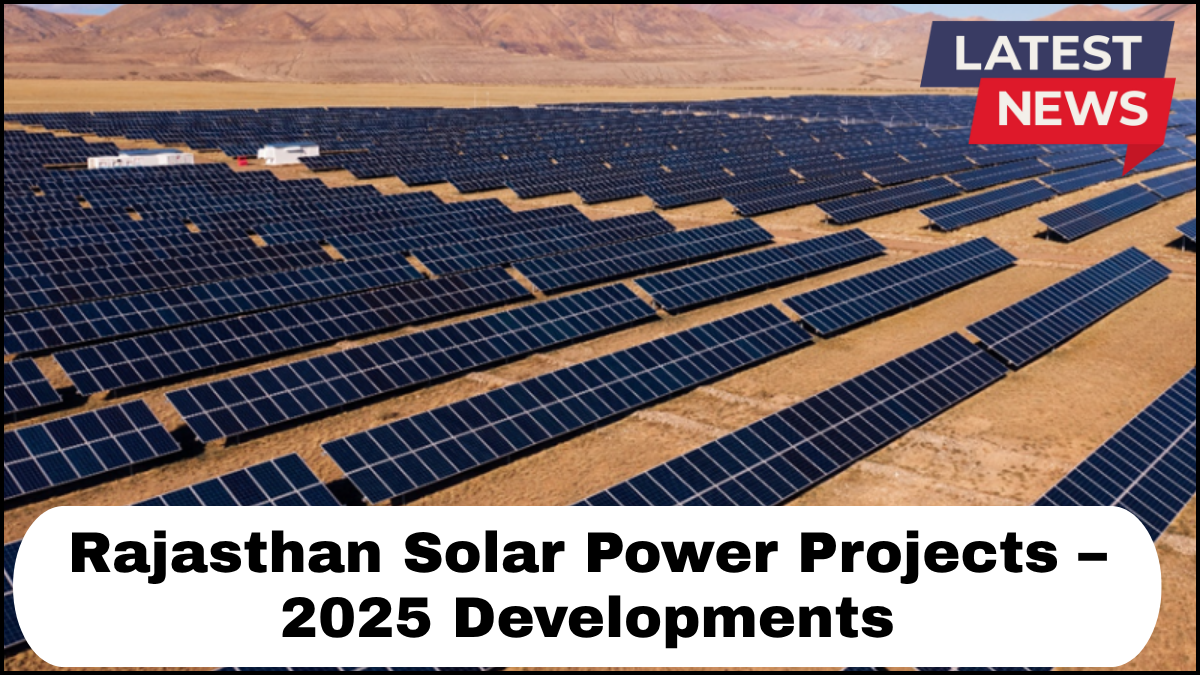Rajasthan is taking the lead in India’s transition to renewable energy, positioning itself as a central hub for solar power development. With vast expanses of desert land and high solar irradiance, the state offers ideal conditions for harnessing solar energy. In 2025, the Rajasthan Solar Power Projects are scaling up rapidly, not just in terms of installed capacity but also in terms of technology adoption, public-private partnerships, and global investment inflows.

Unmatched Solar Potential in Rajasthan
Rajasthan receives over 300 sunny days a year, with solar radiation levels averaging between 5.5 to 6.5 kWh/m²/day. This gives it a natural edge in generating solar power at scale. The state’s geography—flat terrain, low population density in desert regions, and vast tracts of non-agricultural land—makes it well-suited for mega solar installations.
In 2025, Rajasthan is home to some of the largest solar parks in the world, including the Bhadla Solar Park, which alone boasts a capacity of over 2,245 MW. These developments are not just adding gigawatts to the grid but redefining India’s renewable energy strategy.
Major Projects Driving Growth in 2025
Several key solar power projects have reached new milestones in 2025, contributing to Rajasthan’s clean energy surge:
1. Bhadla Solar Park Expansion
The world-renowned Bhadla Solar Park has undergone further expansion in 2025, incorporating smart grid technologies and battery storage systems. The latest phase added 950 MW of capacity, now incorporating AI-driven panel alignment and real-time efficiency monitoring.
2. Chhatar Solar Project
This mid-sized solar farm near Jodhpur has started operations with a capacity of 300 MW. It’s noteworthy for using bifacial solar panels that capture sunlight from both sides, increasing energy output by 10–15% compared to traditional panels.
3. Public-Private Partnership Projects
The Rajasthan Renewable Energy Corporation Limited (RRECL) has partnered with several private entities to develop decentralized solar plants. In 2025, over 1.5 GW of capacity has been added through these collaborative ventures, significantly improving power availability in rural and semi-urban areas.
Policy Push and Investment Momentum
Rajasthan’s solar success story isn’t just about geography—it’s also about policy. The state government’s Rajasthan Solar Energy Policy has laid the foundation for aggressive growth by offering land banks, expedited clearances, and fiscal incentives like stamp duty exemptions.
In 2025, the central government’s PM-KUSUM scheme has also taken off in the state, with over 25,000 solar-powered pumps installed, reducing farmers’ dependence on diesel and promoting sustainable irrigation practices.
Foreign Direct Investment (FDI) is another major driver. Global players such as TotalEnergies, ReNew Power, and Adani Green Energy have committed billions in Rajasthan’s solar infrastructure, enhancing local employment and technology transfer.
Grid Integration and Energy Storage Innovations
One of the critical challenges in scaling up solar energy has been intermittent supply and grid stability. In 2025, Rajasthan is addressing this through integrated battery storage projects and hybrid systems.
The Jaisalmer Renewable Energy Hub, launched in early 2025, combines wind and solar generation with a 200 MW lithium-ion storage facility. This project alone has stabilized power supply to over 2 million homes and reduced curtailment during peak production hours.
Rajasthan’s Role in National Renewable Goals
India aims to achieve 500 GW of renewable energy capacity by 2030, and Rajasthan is a cornerstone of that ambition. With over 20 GW of installed solar capacity already in 2025, the state contributes nearly one-fourth of India’s total solar output.
The state is also emerging as a manufacturing base for solar modules, inverters, and batteries, thanks to the Production Linked Incentive (PLI) scheme which supports domestic manufacturing of clean energy components.
Environmental and Social Impact
Rajasthan’s solar push isn’t just about clean energy—it’s also bringing tangible improvements in quality of life. The electrification of remote villages, improved water access through solar pumps, and job creation in solar operations and maintenance are changing the socio-economic fabric of the region.
Furthermore, environmental impact assessments in 2025 show that solar development has helped reduce carbon emissions by over 30 million tonnes annually, supporting both national and global climate commitments.
Frequently Asked Questions (FAQs)
1. Why is Rajasthan ideal for solar power projects?
Rajasthan has high solar irradiance, over 300 sunny days per year, and large tracts of arid, non-agricultural land, making it perfect for large-scale solar installations.
2. What is the capacity of solar power in Rajasthan as of 2025?
As of 2025, Rajasthan has crossed over 20 GW of installed solar capacity, making it the largest solar power-producing state in India.
3. What are some major solar power projects in Rajasthan?
Key projects include the Bhadla Solar Park, Chhatar Solar Project, and the Jaisalmer Renewable Energy Hub, among others.
4. How does solar energy benefit Rajasthan’s rural areas?
Solar energy has enabled rural electrification, provided solar-powered irrigation pumps, and created jobs in construction and maintenance of solar plants.
5. How is energy storage being managed in Rajasthan’s solar projects?
In 2025, hybrid solar-plus-storage systems and dedicated battery storage facilities are being deployed to ensure stable power supply and reduce intermittency.
click here to learn more